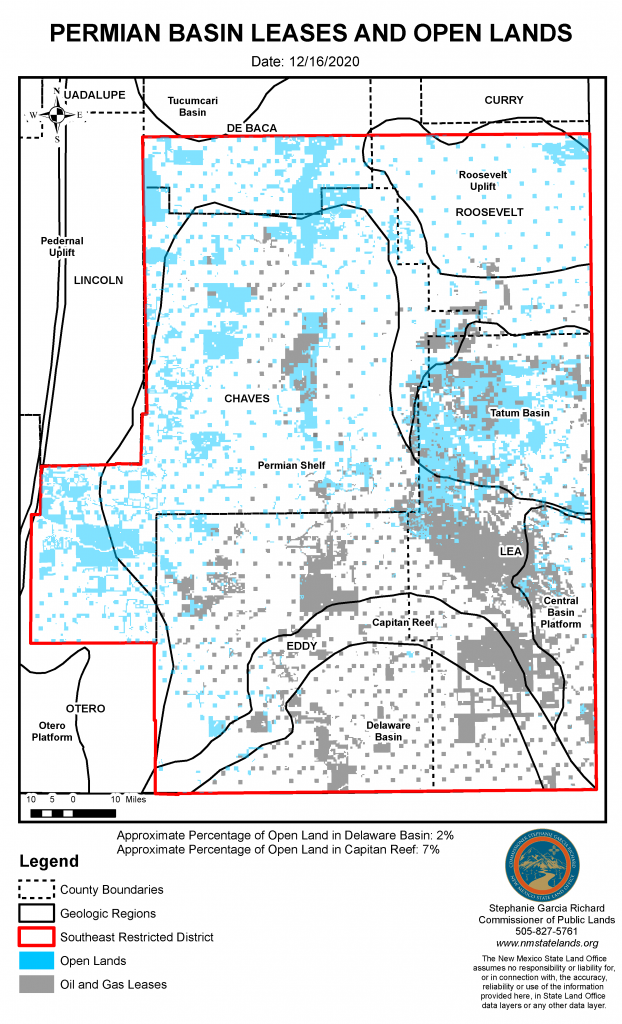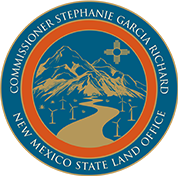FOR IMMEDIATE RELEASE
December 21, 2020
Contact:
Angie Poss, Assistant Commissioner of Communications
505.470.2965
aposs@slo.state.nm.us
State Land Office 2020 Oil and Gas Lease Sales Bring in Nearly $17 Million, Available Oil and Gas Tracts Diminishing
SANTA FE, NM – The New Mexico State Land Office held its final oil and gas lease sale of 2020 on Tuesday, December 15. State Land Office lease sales are held on the third Tuesday of every month, with the recent December sale netting $2.36 million for 2,880 acres, an average of $818 per acre.
The State Land Office exists to raise revenue for New Mexico public schools, hospitals, and colleges. Each acre leased for oil and gas exploration has an assigned beneficiary institution, with the payment for lease bonus sales as well as the subsequent royalties on oil and gas production directly benefiting that beneficiary.
2020 lease sales brought in $16,935,098, with a monthly average of $1.4 million per sale. The 2020 lease sale aggregate revenue is down 67.85% when compared to 2019, where totals were $52,681,098, with a monthly average of $4.4 million. Despite the decline in one time lease sale revenue, the amount that the State Land Office generated per acre for 2020 held to one third of the amount of 2019, or $555 per acre in 2020 and $1,434 per acre in 2019.
The decline in lease sales correlates to the diminishing availability of premium tracts of state trust land mineral estate available for leasing, specifically in the Permian Basin. In general, a lease does not expire as long as it is producing oil and gas so a lease is not able to be “sold” again unless a company fails to develop the lease or it becomes unproductive. That the dollar amount per acre was able to hold to a third of 2019 amounts is thanks in large part to the Office’s Oil, Gas, and Minerals Division taking action to implement a minimum bid process, which began in May 2019. Prior to this process being implemented, bids were set at a per acre price and did not consider the surrounding area, geology, or existing infrastructure.
MAP: Permian Basin State Trust Land Mineral Estate Available for Lease as of December 2020.
After the December 2020 lease sale, only 9% of state trust land mineral estate in the premium part of the Permian is available to be leased; just 2% in the bustling Delaware Basin and 7% in the Capitan Reef.
“We’re taking a hard look at the data available to us, and what it is telling us is that all or almost all of the premium state trust land oil and gas tracts could be held by a lease within the next few years,” Commissioner of Public Lands Stephanie Garcia Richard said. “The State Land Office has taken action to assure that we are making as much money for our beneficiaries as possible from the land that we still have available. Those efforts include the implementation of minimum bids for our oil and gas sales, along with our Accountability and Enforcement Program – which is assuring that land we recover for the Trust is cleaner than before.”
In the 2019 Regular Legislative Session, Commissioner Garcia Richard pushed for an increase in the royalty rate, which is held in the statutory lease form for the State Land Office. The current maximum royalty that the State Land Office is able to collect on the amount of production reported by a company for a lease is 20%, though leases currently in effect range from 12.5% to 20%. Legislation sponsored by Representative Derrick Lente and Senator Bill O’Neill called for an increase to 25%. Because of the range in existing rates, the average actual royalty rate received on oil and gas production on state trust land is about 15.3%.

Under the leadership of Commissioner of Public Lands Stephanie Garcia Richard, the New Mexico State Land Office has seen back-to-back years of revenue over $1 billion. Over 13 million acres of state trust land are leased for a variety of uses, including ranching and farming, renewable energy, business development, mineral development, and outdoor recreation. The money earned from leasing activity supports 22 beneficiaries – New Mexico public schools, seven universities and colleges, the School for the Deaf, the School for the Blind and Visually Impaired, three hospitals, water and land conservation projects, and public building construction and repair.
